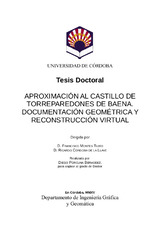Aproximación al castillo de Torreparedones de Baena, documentación geométrica y reconstrucción virtual
Autor
Porcuna Bermúdez, Diego
Director/es
Montes Tubío, Francisco de PaulaCórdoba de la Llave, Ricardo
Editor
Universidad de Córdoba, UCOPressFecha
2015Materia
VirtualPatrimonio
Motor de juego
3D
Castillo
Torreparedones
Heritage
Game engine
Castle
METS:
Mostrar el registro METSPREMIS:
Mostrar el registro PREMISMetadatos
Mostrar el registro completo del ítemResumen
La reconstrucción del patrimonio cultural por medio de técnicas virtuales por ordenador, tiene
actualmente un importante papel científico y documental en las investigaciones de la arqueología,
la ingeniería y la arquitectura. Los avances en la potencia gráfica de los ordenadores, incrementan
el realismo de las representaciones y la calidad de los detalles, permitiendo realizar estudios muy
precisos de la tipología y métodos constructivos. Esto ha permitido poder situar las imágenes y
animaciones gráficas en un escenario virtual, en el que observador y patrimonio se relacionen de
forma interactiva con total libertad de movimientos. Las evidencias arqueológicas de época
medieval en el yacimiento de Torreparedones, identifican un castillo (tipo fortaleza militar) y un
recinto de servicios auxiliares (de tipo industrial: molino y horno de pan ). A través del software de
los motores de juego (usados comúnmente para el entretenimiento) y el diseño de modelos
tridimensionales basados en las hipótesis reconstructivas de los distintos elementos
arqueológicos, se pretende construir un escenario dinámico con elementos del patrimonio cultural
del Castillo de Torreparedones de Baena, para ayudar a investigadores o al público en general a
obtener un conocimiento más detallado e intuitivo de este legado cultural. El escenario virtual,
permite analizar de forma interactiva la hipótesis reconstructiva de la realidad obtenida del estudio,
sin alterar físicamente los restos arqueológicos, con mayor rapidez y versatilidad que las
infografías foto-realistas. Significa un paso más en la investigación y divulgación del patrimonio
mediante la reconstrucción 3D dinamizada con herramientas CAD para videojuegos, recreando
escenarios virtuales de interés cultural, que hacen del observador protagonista de la navegación
entre los elementos patrimoniales representados. Se pretende mostrar como estas técnicas
suponen un importante avance en la investigación y divulgación del patrimonio. The reconstruction of cultural heritage using virtual computer techniques has currently an important
scientific and documentary role in the research of archaeology, engineering and architecture.
Advances in graphical power of computers increase the realism of the representations and the
quality of detail, allowing for very precise studies on the typology and constructive methods. This has allowed to put the images and graphic animations in a virtual scenario, in which the observer
connects with the heritage interactively with total freedom of movement. Archaeological evidence
of Medieval times at Torreparedones site identify a castle (military fortress type) and an area of
auxiliary services (industrial type: mill and bread oven). By using the software of game engines,
commonly used for entertainment and the disign of 3D models based on reconstructive hypotheses
from different archeological elements, is expected to reconstruct a dynamic scenario with elements
of cultural heritage from the Torreparedones Castle of Baena, to help researchers or the general
public to obtain a more detailed and intuitive knowledge of this cultural legacy. The virtual scenario
permits to analyze interactively the reconstructive hypothesis of reality obtained from the study,
without physically altering the archaeological remains, with more versatility and faster than photorealistic
computer graphics. Meaning a further step in the research and dissemination of heritage
by using 3D reconstruction, energized with CAD tools for video games that recreate virtual
scenarios of cultural interest, making the observer to lead the navigation among the patrimonial
elements represented. It is intended to show how these techniques represent an important
advance in research and dissemination of heritage

